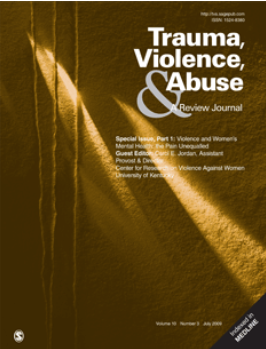研究学术环境中基于性别的暴力的普遍性及其影响:系统回顾和元分析
IF 5.4
1区 社会学
Q1 CRIMINOLOGY & PENOLOGY
引用次数: 0
摘要
学术职场中的性别暴力(GBV)是一个关键问题,它与更广泛的系统性和结构性不平等现象相互交织,但研究却很有限。为了研究学术界人际间基于性别的暴力的发生率、影响和预防措施,我们根据《系统综述和元分析首选报告项目》(Preferred Reporting Items for Systematic Review and Meta-Analysis protocol)进行了元分析和系统综述。使用与性别暴力、工作场所和虚拟工作环境相关的特定关键词,在 PubMed、OVID、Scopus、Web of Science 和 CINAHL 等数据库中进行了严格检索,确定了 2013 年 1 月至 2023 年 2 月间发表的论文。根据 "人群、干预、比较、结果 "框架对研究进行评估。我们提取了论文数据,并按报告的事例进行分组,报告了大学环境中人际间 GBV 的流行率数据,包括人际环境、混合环境和虚拟环境,以及男性、女性和 2SLGBTQ+ 群体中的流行率数据。我们对比例进行了随机效应荟萃分析,以评估 2012 年至 2015 年学术界报告的人际间 GBV 点流行率。仅对大学教职员工、女性和男性进行了分组分析。在 1,290 条记录中,有 16 项研究符合纳入标准。研究发现的暴力类型包括性骚扰、职场欺凌和网络骚扰,这些都会影响职业发展和员工福利。根据 95% 的置信区间 [CI]进行的元分析表明,51.4%(95% CI [39.9%, 63.0%])的大学教职员工遭受过 GBV,其中女性的比例为 59.3% [38.1%, 80.5%],高于男性的 44% [28.1%, 44.1%]。调查结果表明,有必要采取机构干预措施,以解决学术工作场所人际间的性别暴力问题。本文章由计算机程序翻译,如有差异,请以英文原文为准。
Examining the Prevalence and Effects of Gender-based Violence in Academic Settings: A Systematic Review and Meta-analyses
Gender-based violence (GBV) in the academic job sector is a critical issue that intersects with broader systemic and structural inequities, but research is limited. To study the prevalence, effects, and prevention measures of interpersonal GBV within the academic job sector, a meta-analysis and systematic review was conducted in accordance with the Preferred Reporting Items for Systematic Review and Meta-Analysis protocol. Rigorous searches were conducted across the databases PubMed, OVID, Scopus, Web of Science, and CINAHL, using specific keywords related to GBV, workplace, and virtual work environments, identifying papers published between January 2013 and February 2023. Studies were evaluated based on the Population, Intervention, Comparison, Outcomes framework. Data from papers were extracted and grouped by reported instances, and prevalence data for interpersonal GBV were reported in university settings, including in-person, hybrid, and virtual environments, and among men, women, and those who identify as 2SLGBTQ+. A random effects meta-analysis of proportions was conducted to evaluate the reported point prevalence rates of interpersonal GBV in academia between 2012 and 2015. Subgroup analyses were performed for university staff only, females only, and males only. Out of the 1,290 records, 16 studies met the inclusion criteria. The types of violence identified include sexual harassment, workplace bullying and online harassment, which affects career advancement, and employee well-being. The meta-analyses, conducted with a 95% confidence interval [CI], identified that 51.4% (95% CI [39.9%, 63.0%]) of university staff members experience GBV, with females, 59.3% [38.1%, 80.5%], experiencing greater rates than males, 44% [28.1%, 44.1%]. The findings underscore the need for institutional interventions to address interpersonal GBV in academic workplaces.
求助全文
通过发布文献求助,成功后即可免费获取论文全文。
去求助
来源期刊

Trauma Violence & Abuse
Multiple-
CiteScore
13.60
自引率
7.80%
发文量
131
期刊介绍:
Trauma, Violence, & Abuse is devoted to organizing, synthesizing, and expanding knowledge on all force of trauma, abuse, and violence. This peer-reviewed journal is practitioner oriented and will publish only reviews of research, conceptual or theoretical articles, and law review articles. Trauma, Violence, & Abuse is dedicated to professionals and advanced students in clinical training who work with any form of trauma, abuse, and violence. It is intended to compile knowledge that clearly affects practice, policy, and research.
 求助内容:
求助内容: 应助结果提醒方式:
应助结果提醒方式:


